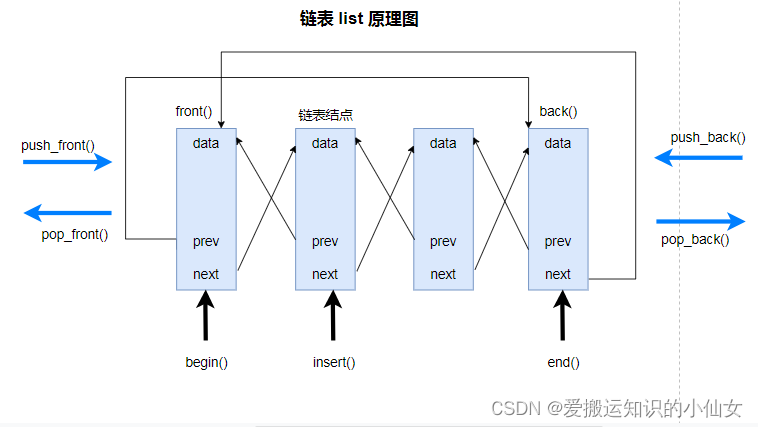重新系统学习c++语言,并将学习过程中的知识在这里抄录、总结、沉淀。同时希望对刷到的朋友有所帮助,一起加油哦!
生命就像一朵花,要拼尽全力绽放!死磕自个儿,身心愉悦!
写在前面,本篇章主要介绍STL中常用容器list。
1.1 list基本概念
功能:将数据进行链式存储。
链表list 的数据存储:是非连续的,数据元素的前后顺序是通过链表中的指针链接来 实现的。
链表的组成: 由一系列的结点组成。
结点的组成:
- 一个数据域,用来存储数据元素。
- 一个指针域,用来存储上一个和下一个结点地址。
链表是一个双向循环链表。 因为指针域可以存储上一个和下一个结点地址,第一个结点的的prev指针指向的是最后一个结点的地址,最后一个结点的next指针指向的第一个结点的地址,使得头尾结点可以相互访问。
链表的迭代器:
由于链表的存储方式不是连续的内存空间,因此链表中的迭代器只支持前移和后移,属于双向迭代器。不是随机迭代器。
list的优点:
- 存储不是连续的,采用动态存储分配,不会造成内存浪费和溢出。
- 插入和删除非常方便,修改指针域即可,不需要移动大量元素。
- 插入和删除都不会造成原有list迭代器失效,这在vector不成立。
list的缺点:
- 灵活,但是空间和时间消耗大。(指针域造成空间消耗大)(在遍历时需要根据指针来判断下一个结点,时间消耗大)
1.2 list构造函数
函数原型:
- list<T> lst; //list采用采用模板类实现,对象的默认构造形式:
- list(beg, end); //构造函数将[beg, end)区间中的元素拷贝给本身。
- list(n, elem); //构造函数将n个elem拷贝给本身。
- list(const list& lst); //拷贝构造函数。
示例:
#include <iostream>
#include <string>
#include<list>
using namespace std;
// list<T> lst; //list采用采用模板类实现,对象的默认构造形式:
// list(beg, end); //构造函数将[beg, end)区间中的元素拷贝给本身。
// list(n, elem); //构造函数将n个elem拷贝给本身。
// list(const list& lst); //拷贝构造函数。
void printList(const list<int>& l) {
for (list<int>::const_iterator it = l.begin(); it != l.end(); it++) {
cout << *it << " ";
}
cout << endl;
}
void test() {
list<int> l;
l.push_back(1);
l.push_back(2);
l.push_front(3);
l.push_front(4);
printList(l);
list<int> l2(l.begin(), l.end());
printList(l2);
list<int> l3(l2);
printList(l3);
list<int>l4(10, 3);
printList(l4);
}
int main() {
test();
system("pause");
return 0;
}1.3 list赋值和交换
函数原型:
- size(); //返回容器中元素的个数empty(); //判断容器是否为空
- resize(num); //重新指定容器的长度为num,若容器变长,则以默认值填充新位置。//如果容器变短,则末尾超出容器长度的元素被删除。
- resize(num, elem); //重新指定容器的长度为num,若容器变长,则以elem值填充新位置。//如果容器变短,则末尾超出容器长度的元素被删除。
示例:
#include <iostream>
#include <string>
#include<list>
using namespace std;
void printList(const list<int>& l) {
for (list<int>::const_iterator it = l.begin(); it != l.end(); it++) {
cout << *it << " ";
}
cout << endl;
}
void test() {
//assign(beg, end); //将[beg, end)区间中的数据拷贝赋值给本身。
list<int> l1;
for (int i = 0; i < 5; i++) {
l1.push_back(i);
}
printList(l1);
list<int>l2;
l2.assign(l1.begin(), l1.end());
printList(l2);
//assign(n, elem); //将n个elem拷贝赋值给本身。
l2.assign(10, 3);
printList(l2);
//list& operator=(const list & lst); //重载等号操作符
list<int> l3;
l3 = l2;
printList(l3);
//swap(lst); //将lst与本身的元素互换。
l1.swap(l3);
cout << "互换后的:" << endl;
printList(l1);
printList(l3);
}
int main() {
test();
system("pause");
return 0;
}1.4 list大小操作
函数原型:
- size(); //返回容器中元素的个数
- empty(); //判断容器是否为空
- resize(num); //重新指定容器的长度为num,若容器变长,则以默认值填充新位置。//如果容器变短,则末尾超出容器长度的元素被删除。
- resize(num, elem); //重新指定容器的长度为num,若容器变长,则以elem值填充新位置。//如果容器变短,则末尾超出容器长度的元素被删除。
示例:
#include <iostream>
#include <string>
#include<list>
using namespace std;
//size(); //返回容器中元素的个数
//empty(); //判断容器是否为空
//resize(num); //重新指定容器的长度为num,若容器变长,则以默认值填充新位置。
// //如果容器变短,则末尾超出容器长度的元素被删除。
//resize(num, elem); //重新指定容器的长度为num,若容器变长,则以elem值填充新位置。
// //如果容器变短,则末尾超出容器长度的元素被删除。
void printList(const list<int>& l) {
for (list<int>::const_iterator it = l.begin(); it != l.end(); it++) {
cout << *it << " ";
}
cout << endl;
}
void test() {
//assign(beg, end); //将[beg, end)区间中的数据拷贝赋值给本身。
list<int> l1;
for (int i = 0; i < 5; i++) {
l1.push_back(i);
}
printList(l1);
if (l1.empty()) {
cout << "l1 为空" << endl;
}
else {
cout << "l1 不为空" << endl;
cout << "l1 size(): " << l1.size() << endl;
}
l1.resize(10);
printList(l1);
l1.resize(20,6);
printList(l1);
l1.resize(3);
printList(l1);
}
int main() {
test();
system("pause");
return 0;
}输出:
0 1 2 3 4
l1 不为空
l1 size(): 5
0 1 2 3 4 0 0 0 0 0
0 1 2 3 4 0 0 0 0 0 6 6 6 6 6 6 6 6 6 6
0 1 2
1.5 list插入和删除
函数原型:
- push_back(elem); //在容器尾部加入一个元素
- pop_back(); //删除容器中最后一个元素
- push_front(elem); //在容器开头插入一个元素
- pop_front(); //从容器开头移除第一个元素
- insert(pos, elem); //在pos位置插elem元素的拷贝,返回新数据的位置。
- insert(pos, n, elem); //在pos位置插入n个elem数据,无返回值。
- insert(pos, beg, end); //在pos位置插入[beg,end)区间的数据,无返回值。
- clear(); //移除容器的所有数据
- erase(beg, end); //删除[beg,end)区间的数据,返回下一个数据的位置。
- erase(pos); //删除pos位置的数据,返回下一个数据的位置。
- remove(elem); //删除容器中所有与elem值匹配的元素。
示例:
#include <iostream>
#include <string>
#include<list>
using namespace std;
void printList(const list<int>& l) {
for (auto item : l) {
cout << item << " ";
}
cout << endl;
}
void test() {
list<int> l1;
for (int i = 0; i < 5; i++) {
//push_back(elem);//在容器尾部加入一个元素
l1.push_back(i);
}
//push_front(elem);//在容器开头插入一个元素
l1.push_front(5);
printList(l1);// 5 0 1 2 3 4
//pop_front();//从容器开头移除第一个元素
l1.pop_front();
printList(l1);// 0 1 2 3 4
//pop_back();//删除容器中最后一个元素
l1.pop_back();
printList(l1);// 0 1 2 3
//insert(pos, elem);//在pos位置插elem元素的拷贝,返回新数据的位置。
l1.insert(l1.begin(), 100);
printList(l1);// 100 0 1 2 3
//insert(pos, n, elem);//在pos位置插入n个elem数据,无返回值。
l1.insert(l1.end(), 3, 200);
printList(l1);//100 0 1 2 3 200 200 200
//insert(pos, beg, end);//在pos位置插入[beg,end)区间的数据,无返回值。
l1.insert(l1.begin(), l1.begin(), l1.end());
printList(l1);//100 0 1 2 3 200 200 200 100 0 1 2 3 200 200 200
//erase(beg, end);//删除[beg,end)区间的数据,返回下一个数据的位置。
l1.erase(l1.begin(), ++l1.begin());
printList(l1);//0 1 2 3 200 200 200 100 0 1 2 3 200 200 200
//erase(pos);//删除pos位置的数据,返回下一个数据的位置。
l1.erase(++l1.begin());
printList(l1);//0 2 3 200 200 200 100 0 1 2 3 200 200 200
//remove(elem);//删除容器中所有与elem值匹配的元素。
l1.remove(200);
printList(l1);//0 2 3 100 0 1 2 3
//clear();//移除容器的所有数据
l1.clear();
printList(l1);
}
int main() {
test();
system("pause");
return 0;
}
1.6 list数据存取
函数原型:
- front(); //返回第一个元素
- back(); //返回最后一个元素
示例:
#include <iostream>
#include <string>
#include<list>
using namespace std;
void test() {
list<int> l;
l.push_back(1);
l.push_back(2);
l.push_back(3);
l.push_back(4);
// l[0]; // 错误
// l.at(0); // 错误
// 原因:list本质是双向迭代器,不是随机迭代器,不支持随机访问,不是连续线性存储。
cout << "first item: " << l.front() << endl;
cout << "last item: " << l.back() << endl;
list<int>::iterator it = l.begin();
it++;// 支持双向
it++++;
it--;
//it = it + 1;//不支持随机访问 即便是+1;
}
int main() {
test();
system("pause");
return 0;
}1.7 list反转和排序
函数原型:
- reverse(); 反转链表
- sort(); 链表排序,默认升序
示例:
#include <iostream>
#include <string>
#include<list>
#include<algorithm>
using namespace std;
void printList(const list<int>& l) {
for (auto item : l) {
cout << item << " ";
}
cout << endl;
}
bool myCompare(int v1, int v2) {
// 降序 就让第一个数 > 第二个数
return v1 > v2;
}
void test() {
list<int> l;
for (int i = 0; i < 5; i++) {
l.push_back(i);
}
printList(l);
l.reverse();
printList(l);
//所有不支持随机访问迭代器的容器,不可以用标准算法
// 不支持随机访问迭代器的容器,内部会提供对应的算法
//sort(l.begin(), l.end());
//使用容器内部算法排序 sort排序,默认升序
l.sort();
cout << "升序:" << endl;
printList(l);
l.sort(myCompare);
cout << "降序:" << endl;
printList(l);
}
int main() {
test();
system("pause");
return 0;
}
1.8 list排序案例
需求描述:
自定义person类,包含姓名、年龄、升高属性。
排序规则,按照年龄升序,若年龄相同,按照身高降序。
示例:
#include <iostream>
#include <string>
#include<list>
using namespace std;
class Person {
public:
Person(string name,int age,int height) {
this->m_name = name;
this->m_age = age;
this->m_height=height;
}
string m_name;
int m_age;
int m_height;
};
bool myCompare(Person& p1, Person& p2) {
// 年龄相同 按照升高降序
if (p1.m_age == p2.m_age) {
return p1.m_height > p2.m_height;
}
else {
//按照年龄 升序
return p1.m_age < p2.m_age;
}
}
void printPerson(const list<Person>& l) {
for (auto item : l) {
cout << "name: " << item.m_name
<< " age: " << item.m_age
<< " height: " << item.m_height
<< endl;
}
}
void test() {
Person p1("echo", 20, 150);
Person p2("lisa", 25, 170);
Person p3("mesa", 20, 160);
list<Person> l;
l.push_back(p1);
l.push_back(p2);
l.push_back(p3);
printPerson(l);
l.sort(myCompare);
cout << "排序后:" << endl;
printPerson(l);
}
int main() {
test();
system("pause");
return 0;
}
